Whether you are a home sewer looking for the perfect machine or an antique collector interested in the history of sewing machines, you have probably come across Kenmore brand machines. Over the years, many different Kenmore sewing machine models appeared on the market.
Sears Roebuck sold Kenmore sewing machines from 1913 through 2013. Different companies manufactured the machines that Sears-branded as “Kenmore.” These budget sewing machines are typically described as sturdy, affordable, and capable of completing basic sewing tasks.
In this article, you will learn about the history, models, and value of vintage Kenmore sewing machines.
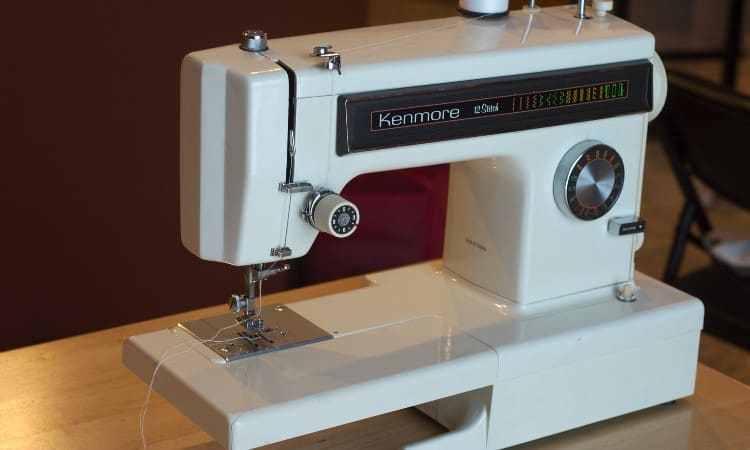
Kenmore Sewing Machine flickr photo by mbaylor (1)
Quick Navigation
- History of Kenmore Sewing Machines
- Why Can’t I Find Kenmore Machines Today?
- Popular Kenmore Sewing Machine Models
- Are Kenmore Sewing Machines Worth Money Today?
- Where to Buy a Vintage Kenmore Sewing Machine
- What to Consider When Buying a Kenmore Sewing Machine
- Can I Use My Vintage Kenmore Sewing Machine?
- Kenmore Parts, Sergers, and Accessories
- Conclusion
History of Kenmore Sewing Machines
Kenmore models made a big impact in sewing history because Sears Roebuck sold them. Without delving too deeply into American history, Sears essentially reshaped the way Americans shopped in the late 1800s-early 1900s.
The company designed an extensive mail-order catalog that could reach the farmers and settlers spread out across rural America. In case you are picturing the flimsy, glossy copy of People Magazine you can easily tuck into your purse, think again! By the beginning of the 20th century, the Sears catalog was more than 500 pages long!
Anything included in the Sears catalog could potentially be seen by every consumer in the nation. Because of this, the Sears Kenmore brand quickly became very popular.
Sears carried its first Kenmore sewing machine model from 1913-1919. This treadle-powered model sold for just $6.75! You probably spend this amount on a cup of coffee at Starbucks now, but in the early 1900s, the price would have been equal to about $180 today.
World War I interrupted the manufacturing of domestic items like sewing machines, though, causing Sears to temporarily halt its production. The company resumed the profitable business again in the 1930s, launching some of their most popular electric-powered Kenmore brands in 1933.
Starting in 1933, Sears sold machines made by White. Some of these models were branded and sold as White sewing machines. However, some of them were branded with the Sears Kenmore brand.
World War II caused another break in production. Sears did not sell any machines from 1942-1948. Following the war, the company continued to sell White models, some branded with the Kenmore brand, until 1958.
In the 1950s, White lost its contract with Sears. Sears applied the Kenmore brand to a new batch of machines manufactured overseas in Japan. These models featured fancy new abilities, like buttonhole making, zig-zagging, and other fancy stitching.
Some people argue that this batch of Sears Kenmore lacked the sturdy quality that had characterized the earlier Kenmores, though.
Singer also briefly made a couple of Sears Kenmore sewing machine models in the 1970s.
Janome was one of the Japanese companies that quickly grew to global prominence during this era. They manufactured Kenmore models for Sears until 2013.
Following bankruptcy in the early 2000s, Sears stopped selling sewing machines under the Kenmore brand.
Why Can’t I Find Kenmore Machines Today?
While you can still find Kenmore machines for sale in many places like eBay and Amazon, Sears no longer manufactures or sells sewing machines.
This change occurred sometime between 2013 and 2019. Sears stopped selling Janome models branded as Kenmore and held a big clearance sale to get rid of its inventory around 2013.
During this period, Sears also declared bankruptcy and broke its partnership with the companies that had manufactured the items sold under the Kenmore brand (at various times, these companies included Whirlpool, Janome, and LG).
Sears department stores and their website no longer carry sewing machines, though you can find some models sold by third parties through Sears Marketplace.
Can I Buy a New Kenmore Sewing Machine?
You cannot buy a brand-new Sears Kenmore sewing machine because they are no longer in production.
When did Kenmore stop making sewing machines? Well, “Kenmore” didn’t exactly make machines to begin with. Kenmore was a brand name that Sears applied to different sewing machine manufacturers who had a contract with them.
Most recently, Janome made models sold under the Kenmore brand. These are not for sale right now. The newest models, sold as recently as 2013, included modern options like computerized features and embroidery machine capabilities.
Popular Kenmore Sewing Machine Models
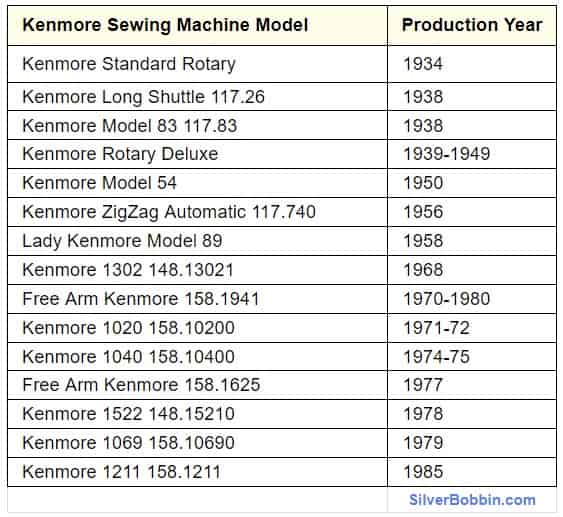
While not a comprehensive list, here are a few highlights of the most popular Kenmore sewing machine models. Sears sold many different models over the years and every sewer who uses a Kenmore model claims that her model is the best one!
Every model has its own quirks and abilities, though, so you will have to decide for yourself!
How to Identify the Model of a Kenmore Sewing Machine
First, a quick word about model numbers. All Sears Kenmore sewing machine models have a model number inscribed on them. This number begins with a three-digit code, such as 117 or 385. If you have a Kenmore machine, locate this number and you will be able to determine what year Sears sold that model.
Kenmore 117
The 117 models are some of Kenmore’s earlier models, produced during the 1940s. White, a company known for simple but reliable machines, manufactured all of the Kenmore 117 models.
These models ran on electricity but performed only basic functions. They also came built into a sturdy wooden table cabinet!
Kenmore 158
The 158 models were manufactured in the 60s and 70s by overseas companies, then marketed and sold under the Kenmore brand. Users describe these models as so simple that a child could easily figure them out!
Most of these models provided solid, sturdy craftsmanship without a lot of bells and whistles.
Kenmore Model 158.1941
The Kenmore 158.1941 is sometimes ranked as the all-time best Kenmore model. It featured a more powerful motor than many other machines at the time.
Kenmore 385
Janome, a Japanese company known today for high-quality, computerized machines, manufactured any Kenmore models with numbers beginning with “385.” Sears began selling Janome-manufactured models after about 1965.
This can be confusing because Kenmore’s most recent models, made in the 2000s, are also 385s!
The “Kenmore 30”
The Kenmore 385.1884180, also known as the “30 stitch,” was sold into the 1980s. This solid machine performs an outstanding number of stitches for a pre-computer-era model! Users also like the zigzag stitch on this model.
Are Kenmore Sewing Machines Worth Money Today?
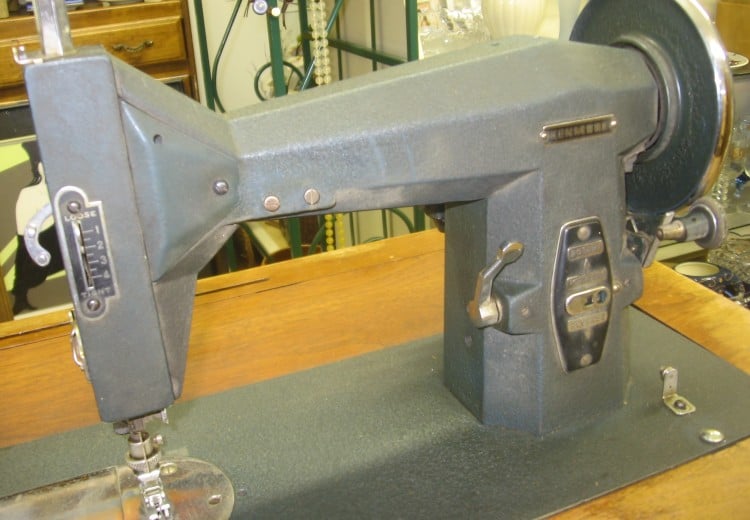
Old Kenmore sewing machine Source: TheLivingRoominKenmore (2)
Antique and vintage Kenmore machines usually sell for $100-$500, depending on their collectability level. In general, antique and vintage sewing machines are not worth a lot of money. Some newer Kenmore machines, especially the ones made by Janome, may fetch around $400.
Kenmore machines offered a budget-friendly option for the home sewer. They never claimed to be high-class or the best machine ever made. However, many of their models through the 1970s were constructed with metal parts, making them sturdy and often still usable today.
Unique Characteristics of Kenmore Sewing Machines
Each Sears Kenmore sewing machine model has its own pros and cons, which makes it tricky to clearly state whether or not Kenmore models are good sewing machines.
Many home sewers love their vintage Kenmore models and still use them today. That said, in many ways, Sears Kenmore models were the “everyman’s machine.”
Sears focused on accessibility and wide distribution rather than on creating an artisanal one-of-a-kind item. This is why many people would describe the Kenmore as a budget machine.
Every sewing machine brand and model has its slight variations. Some Kenmore sewing machine models feature a uniquely high presser foot. This allows the sewer to easily insert thick fabrics such as denim.
Are Antique Sewing Machines Valuable?
Few old sewing machines are very valuable. Some rare models become expensive collector’s items, but usually, antique machines run from $100-$500. Even then, you will probably find many more machines available on the $100 end of the spectrum.
What makes a sewing machine a collector’s item? Well, anything made before 1900 is a genuine antique. This means it is probably rarer and possibly worth more money than a sewing machine made after 1900 (technically, 20th-century machines are termed vintage, not antique).
A machine in mint condition will sell for more than one in poor condition. Likewise, a machine that still runs will probably sell for more than a broken-down one.
Here are a couple of examples of vintage Kenmore sewing machine models and their typical pricing to give you an idea of the market.
First, let’s take a look at a vintage Sears Kenmore sewing machine in a cabinet. A number of the pre-1960s models came built into wooden table cabinets. On eBay, you can find these models for sale for as little as $100, probably because Sears sold these popular models in great quantities.
Second, let’s look at a Sears Kenmore sewing machine model 1120. Made in Japan out of solid metal parts, this vintage model also goes for just about $100 (give or take a few dollars between sellers).
Where to Buy a Vintage Kenmore Sewing Machine
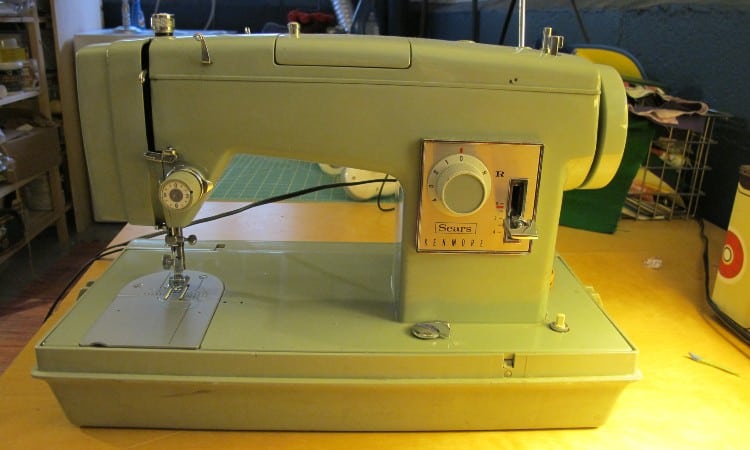
Old Sears sewing machine Source: mollystevens (4)
The easiest way to buy a vintage Sears Kenmore machine is to search eBay and Craigslist. Because of its focus on arts and crafts, Etsy has some models for sale as well.
If you want a true antique, possibly with an interesting provenance story, you could try visiting antique stores. Just be aware that collectors usually sell more valuable models in good condition but with a higher price tag.
Some sewers report finding old Kenmore models for way cheap at thrift stores, too, though you get no guarantee of workable condition there.
The bottom line is that if you want to buy a vintage or antique Kenmore machine, you need to look in the places you can find old and used things for sale.
What to Know When You Buy Vintage
Kenmore sewing machines aren’t worth a lot of money today, but the silver lining here is that you can often buy a vintage machine cheaply!
Ideally, you should ask the seller for the machine’s model number or examine the machine in person to find this number. That way, you can look up the decade this machine was built.
Once you know what model it is, you can deduce what features the machine has and find out what kind of sewing it can do. You can also make an educated guess that if it was made pre-1970s, its insides are probably metal, not plastic. This means it will be more durable.
Finally, you need to know whether you plan to resell the machine or use it yourself! If you plan to sew with the machine, you need to make sure it works.
How Can You Determine the Value of the Antique?
Once you know the machine’s model number, a quick search on eBay will give you a fair idea of the average price range for this machine.
However, you should also consider the overall condition of the machine before making a purchase. Pretty decals, a pristine paint job, and an unscratched wooden cabinet or table (if it has one) indicate a probability that the machine is worth more money.
What to Consider When Buying a Kenmore Sewing Machine
Here are a few questions to consider while deciding whether or not you want a vintage sewing machine. Many sewing enthusiasts love the reliability of vintage tools!
First, what are the pros and cons of vintage vs new?
Vintage machines are usually durable, made of tougher materials than their modern counterparts. Their simple design makes them easy to understand and use. Vintage machines are often cheaper than computerized models, too.
On the downside, vintage machines lack the functionality of a new, computerized appliance. They tend to weigh a lot and are not super mobile because of this. They often require more repair and maintenance, too.
Do you need mobility?
If you plan to take your machine on the road with you to a sewing circle or class, or even when you pack up your house to move, you may want a newer machine. Vintage machines weigh a lot because they are made of metal. Plus, some of them come built into cabinets!
Finally, what condition is the machine in?
Before buying a vintage machine, you want to verify that it works. Many old machines do seem to last forever, but this only happens when they are treated right!
Can I Use My Vintage Kenmore Sewing Machine?
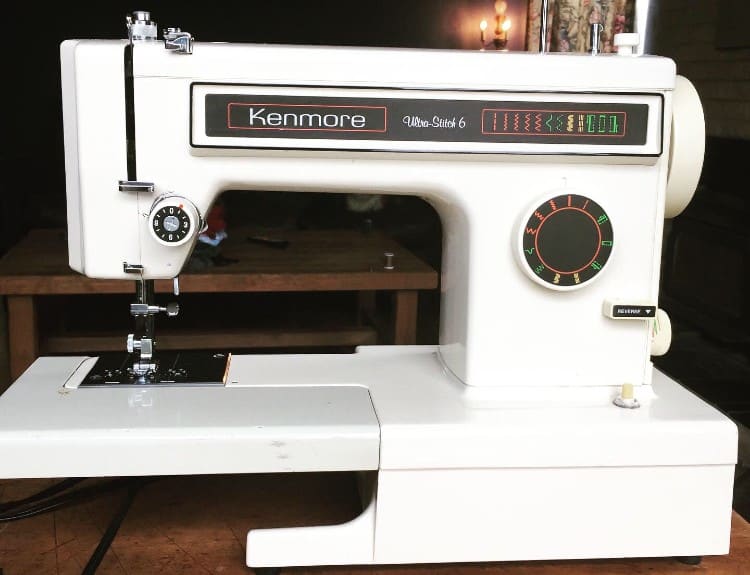
Kenmore vintage sewing machine. Source: kellyhogaboom (3)
Many home sewers keep vintage Kenmore machines running with a bit of extra care. They consider their vintage machines worth the effort because these old “workhorses” can do things that modern machines can’t!
For example, you may find it useful to have a vintage sewing machine on hand for tasks like quilting, requiring sewing through multiple layers of fabric and batting.
Vintage Kenmore sewing machine models do have limitations. Some can only sew a straight stitch, for example. Others can perform fancy stitches and make buttonholes.
No matter what model you have, to use your vintage machine, you need to know how to set it up, what it can do, and how to maintain it.
How to Thread Your Machine
Any time you use your sewing machine, you have to start by threading it. Your machine is designed to pull a thread through a series of gears and levers into the needle. The thread path is usually pretty simple, but unfortunately, it does differ from brand to brand and model to model.
When threading your vintage machine, the first thing you should do is refer to the user’s manual. This wonderful little pamphlet almost certainly includes pictures illustrating where to place the thread before you start sewing.
If you bought a used machine that didn’t come with this essential document, don’t panic! You can easily find Kenmore manuals through the Sears website, for free.
Secondly, remember that you don’t have to invent the wheel yourself. There’s a whole community of sewing enthusiasts out there, and someone has undoubtedly posted a video or blog showing how to thread your particular vintage machine!
Unless you are super good at visualizing, you probably shouldn’t try to follow just written instructions for this task. It’s easier to have a picture to look at!
Is it Easy to Use a Vintage Machine?
Some people find vintage machines very easy to use because of their simplicity. Others find their lack of advanced functionality frustrating. Like any piece of equipment, vintage machines have pros and cons.
People who love using their vintage machines enthuse over their durability. It’s true that modern machines quite literally are not made the way they used to be. COmpanies built older machines, especially any produced before 1970, out of metal parts. Today, most domestic machines have plastic components instead.
Some sewers also enjoy the simplicity of vintage machines. While most Kenmore machines are powered by electricity, the vintage machines are not computerized and often perform limited varieties of stitches.
On the other hand, some people dislike using vintage machines for several reasons. A couple of the top concerns commonly listed are noise levels and repair costs.
Older machines can make loud whirring noises while they run. Some machines came built into wooden cabinets to muffle this noise. Usually, you can mitigate this by giving the motor a good cleaning, though.
Not everyone has to take their vintage machine in for special repairs, but like any small, somewhat complex appliance, things can get old or off-kilter and require adjustment on occasion.
How to Repair Your Kenmore Machine
If you feel confident in your mechanical abilities, you can try making simple repairs to your machine yourself!
Here are a few simple tasks to try before taking your machine in for repairs:
- Clean and oil it. The manual should indicate which parts need oiling. Usually, anything that moves needs oil!
- Replace the needle. Professional seamstresses recommend switching out the needle after every sewing project because it gets blunt so easily.
- Re-thread everything, including the bobbin. You might think you did it perfectly the first time, but it only takes a few seconds and it doesn’t hurt to try!
- Replace the lightbulb. Not all vintage machines have a light over the needle, but this is an easy fix that could save you as much as $100 in repair fees!
Kenmore Sewing Machine Manual
Sewing machine manuals provide diagrams showing how to clean, thread, perform simple repairs on your machine. These tasks will keep it running for as long as possible.
These manuals also describe in detail what features your machine has. For this reason, they are a great resource you should seek out before making a purchase!
Have you ever opened a new product, pulled it out of the box, and tossed aside the user’s guide that came with it? You probably figure you don’t need help setting up a toaster oven or a hairdryer.
Here’s the thing: you do need the manual for your sewing machine. Everyone agrees on this point. Even expert home sewers refer to the manual regularly!
Kenmore users are lucky. Go to this Sears website and register for free. On the top search bar, you will then see an option to select “manuals.” After that, all you have to do is type your model number into the search!
Kenmore Parts, Sergers, and Accessories
Because Kenmore models were so recently discontinued, Kenmore fans are fortunate to have a lot of support from Sears. The Sears website still provides access to various parts sellers.
Of course, you do have to pay for these parts! But you may find repairing your reliable vintage machine to be more cost-effective than purchasing a fancy new one.
As with most things vintage, you can also search for parts on eBay or Etsy.
Sears sold Kenmore for over a century. During that time, they also sold various accessories. You can find table cabinets for your sewing machine, fancy feet, and buttonhole extensions. Of course, these accessories must be paired only with the model they were made for!
You can also find newer models of Kenmore sergers and embroidery machines for sale. Janome manufactured most of these. They tend to have good reviews, though they come with a higher price tag than the average domestic sewing machine.
Conclusion
Hopefully, you now feel like an expert on vintage Kenmore sewing machines! You know all about the history of these Sears products, where to buy them today, and how much they typically cost.
You also got some tips for using a vintage sewing machine, including easy repairs to try yourself.
Are you looking into buying a vintage Kenmore machine? Do you have one at home that you want to learn how to use? Leave a comment below to let us know!
(1),(2) Photos shared under a Creative Commons (BY) license
(3),(4) Photo shared under a Creative Commons (BY-SA) license
Nancy Pate
Sunday 31st of October 2021
I have acquired a Sears Roebuck Zig Zag sewing machine Model #158-12411. I want to fix it up to give to my great niece when I teach her how to sew later this year. I want to know how old this machine is? It was made in Japan. From what I have looked up, it appears to have been made in the 1970's. Can you tell me more specifically?
Brandee Earnest
Friday 22nd of October 2021
Kenmore 10 stitches 158 13500 model works good condition how much is it worth
Darla
Friday 24th of September 2021
Really nice article on Kenmore Sewing Machines. I have my Moms Green Kenmore 158.1316 from the early 70's I learned to sew on that machine and it still runs. Thank You for a really great read on Kenmore Sewing Machines.
Germaine
Tuesday 31st of August 2021
I have my Mother’s vintage Kenmore sewing machine. It is 50 plus years old. Still works great!
Teresa Naccarato
Wednesday 9th of June 2021
I've owned my vintage machine for over 30 years . I love it's reliability . It has never failed me. I've used it on pretty much every kind of material including canvas and leather. I was very happy to find the rubber replacement parts for my Kenmore rotory # 117-552 still being sold ! Oh happy day.